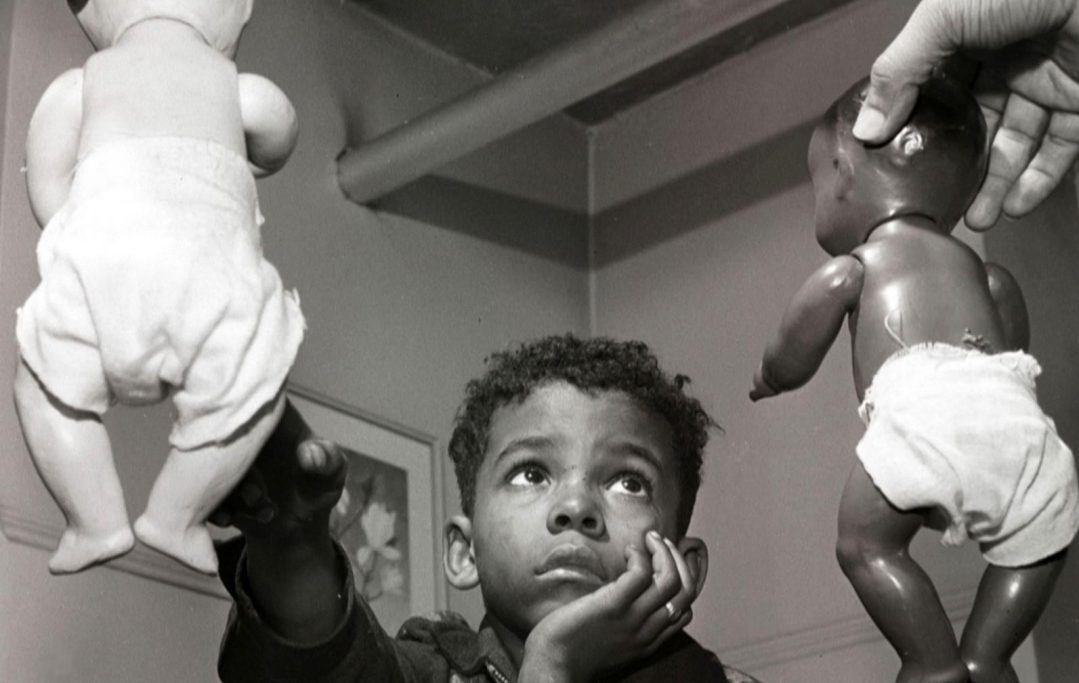By 1954, there were a growing number of Americans who had come to realize that America’s unwillingness to deal with its institutionalized “inequities” regarding race were damaging its “brand” throughout the world. But actually doing something about it, well that was a whole different beast.
Remember when Tommy Burns was getting beat down by Jack Johnson? He almost died because neither the ref nor his corner wanted to throw in the towel because that would mean handing the heavyweight championship over to a Black man? Well, no one wanted to be the one to overturn Plessy v. Ferguson either, not without “evidence”.
I mean, if you don’t actually think too hard about it, just skimming the surface, “separate but equal” sounds fair, right?
I mean what’s there to complain about if both groups have the exact same things for them to use, right?
But imagine you are a child in school and your teacher tells the class that it’s recess time. You put on your hat and coat or what have you to go outside and play but only after the other kids get their hats and coats on first. Then when you are allowed to get up you have to stand in your own line separate from everyone else. The teacher allows the first line of 28 kids out first and then you get to follow them. Once outside, there are two identical sets of playground equipment. The 28 kids who came out first play on one and you must play on the other.
When you’re thirsty there are always two drinking fountains, both exactly the same, one drinking fountain for the other 28 kids and a different one for you.
How does any of this make you feel? I would think it would be natural to ask, “What’s wrong with me? Why can’t I use the same drinking fountain or playground set as the rest of the kids?”
But you aren’t the only one asking that question. The other 28 kids are asking the same question about you, “What’s wrong with them?”
Separate but equal seems harmless when you are talking about “things” but what real world effect does forcing people to sit in the back of the bus, drink out of different drinking fountains, not being able to try on clothing in department stores have on real life people?
But the million dollar question was, had anyone ever bothered to do a scientific study on the effects of segregation in America?
Well in 1939 someone did.
Their names were Kenneth and Mamie Clark and they were married Black psychologists and they published several major papers in 1939 and 1940 on the effects of segregation on self-perception in relation to race. What the Clarks did was they took a group of Black children who were attending integrated schools in New York and compared them to a group of Black children attending segregated schools in Washington DC.
In the now famous “Doll experiment” the Clarks would present these children with two dolls. Both dolls were completely identical except for the skin and hair color. One doll was white with yellow hair and the other doll was brown with black hair. The Black child was then asked which doll was the “nice” doll, which one looks “bad”, which one has the “nicer” color and what the Clarks proved, scientifically, for the first time ever, was that these children showed a clear, undeniable preference for the white doll by all the Black children attending segregated schools.
For the first time EVER, someone used scientific methods to measure and expose the damage that White supremacy was having on creating self-hatred within Black children.
This Doll Test study became the basis of the Supreme Court striking down the separate but legal doctrine that had stood as the law of the land since Plessey verse Ferguson. Finally, there was evidence that segregation itself creates, “a feeling of inferiority as to their status in the community”.
Of course it does. That is the point of segregation.
And in other news, men who do pushups are more likely to gain muscle tone in their arms and chest than men that don’t and single women who go to parties meet more men than women that stay at home and never leave the house.
For 250 unbroken years in America every social interaction with White Americans and their enslaved article of merchandise was intended to reinforce simultaneously the inferiority of the person of African descent and the superiority of the person of European descent. The entire system necessitated the African feeling less than to accept this status.
So if you wanted to strike down a cornerstone of the American way of life, a legacy system if you will, from those 250 years of slavery, as segregation was, the only way it was going to be done was by using irrefutable science.
Oh yeah, and it also helps to have a Supreme Court that was open to the evidence.
Had you presented the very same evidence in 1897, that segregation itself creates, “a feeling of inferiority”, that court would’ve looked at you and asked, “So what? Blacks feel inferior to whites? They are. What is your point?”
But it takes two to tango, right? If White supremacy has caused Blacks to internalize racial bias inwards towards themselves, what effect has white supremacy had on Whites?
In 2006, Neuroscientist David Amodio conducted a study with more than 150 White college students who were all asked to categorize words as “pleasant” or “unpleasant”, “mental” or “physical” immediately after being shown a Black or White face.
When they were shown a Black face they were much more likely to label that Black face with “unpleasant” than a White face. So when they were given a list of tasks some physical and some mental, and then when they were asked to assign these task to these faces, again the Black faces were given the physical tasks; the White faces were assigned the mental tasks.
The following year in 2007, a study was published in the US National Library of Medicine National Institutes of Health which showed a frightening bias among White physicians. The study provided evidence that White physicians were less likely to prescribe potentially life-saving treatments to Black patients than White patients even when using the exact same medical histories. In this particular study researchers gave 220 White medical residents a patient’s medical history with the same diagnosis, the patient was experiencing chest pain, suggesting that the patient was having a heart attack.
When the patient was Black, White doctors were less likely to prescribe thrombolysis, a drug treatment to reduce blood clots and prevent heart attacks, than when the patients were White.
Let that sink in for a second.
The only difference between the medical histories was the race of the patient.
This meant that White doctors were more likely to prescribe a potentially life-saving treatment to White patients than Black patients.
But it’s not just in medicine.
In the judicial system this manifests as Blacks doing more time in jail than Whites for the exact same crimes.
In education it manifests as Black children representing 48 percent of preschoolers being suspended more than once from school, yet Black children only making up 18 percent of preschool enrollment.
This trend continues even when they get older as Black students are three times more likely to be suspended than White students for the same offenses.
The Neuroscientist, Scientists and Psychologists who have been conducting these studies over the past 60 years or so don’t just label people “racist” like you and I might do. Nowadays they prefer to use the term “implicit racial bias”.
They do this because what they have found through research is that many Whites don’t consciously realize that they are “racially biased”. It doesn’t make them any less “racist” or “racially biased” but their lack of self-reflection makes them less likely to recognize it.
If you asked these students or these physicians directly, “are you prejudiced?” outside of the extreme cases where someone has a swastika tattooed in the middle of his forehead, they would probably say that they aren’t, but research suggests that they most certainly are.
The same goes for Black Americans.
Do you think these kids that participated in Clark’s Doll Test wake up every morning and say, “Boy, it sure does feel shitty being Black”?
No, they don’t.
If you were to walk up to someone Black and ask them if they think of themselves as inferior to Whites I am sure they will deny it, but again, research suggest that they most certainly do.
It’s like Malcolm X famously said “The Black man in the Western Hemisphere—North America, Central America, South America, and in the Caribbean—is the best example of how one can be made, skillfully, to hate himself that you can find anywhere on this earth.”
Far, far, far too often we focus only on people who act out consciously on their racial bias.
We pay too much attention to those on the extreme end of the spectrum where their racial bias is something that they act on consciously.
Had Clark never asked those Black children if they preferred the white doll over the black doll they still would’ve felt the same way, probably never even questioned why they felt that way.
For the overwhelming majority of people racial bias is not a conscious decision. Cognitive biases allow us to create our own little individual “subjective social reality”
And there is a growing mountain of scientific evidence to support that fact.
But one thing that these researchers all agree on is where this racial bias comes from.
It is learned.

